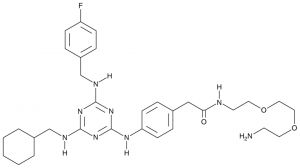This product is for research use only, not for human use. We do not sell to patients.

| Size | Price | Stock |
|---|---|---|
| 100mg | $1050 | In Stock |
| 200mg | $1575 | In Stock |
| 500mg | $2655 | In Stock |
Cat #: V1871 CAS #: 1177827-73-4 Purity ≥ 98%
Description: AP-III-a4 (also known as ENOblock) is a novel and potent small molecule inhibitor of enolase which is isolated by small molecule screening in a cancer cell assay to detect cytotoxic agents that function in hypoxic conditions, which has previously been shown to induce drug resistance.
Publications Citing InvivoChem Products
Product Promise

- Physicochemical and Storage Information
- Protocol
- Related Biological Data
- Stock Solution Preparation
- Quality Control Documentation
| Molecular Weight (MW) | 594.72 |
|---|---|
| Molecular Formula | C31H44ClFN8O3 |
| CAS No. | 1177827-73-4 |
| Storage | -20℃ for 3 years in powder formr |
| -80℃ for 2 years in solvent | |
| Solubility In Vitro | DMSO: 100 mg/mL (158.4 mM)r |
| Water: 100 mg/mL (158.4 mM)r | |
| Ethanol: 100 mg/mL (158.4 mM) | |
| SMILES Code | O=C(NCCOCCOCCN)CC1=CC=C(NC2=NC(NCC3CCCCC3)=NC(NCC4=CC=C(F)C=C4)=N2)C=C1 |
| Synonyms | AP-III-a4; ENOblock |
| Protocol | In Vitro | AP-III-a4 (10 μM; 24 h) can induce glucose uptake and inhibit phosphoenolpyruvate carboxykinase (PEPCK) expression in hepatocytes and kidney cells. AP-III-a4 (0-10 μM; 24 or 48 h) inhibits cancer cell migration and invasion, induces cancer cell apoptosis. AP-III-a4 directly binds to enolase and inhibits its activity. AP-III-a4 (ENOblock) (0-10 μM; 24 h) inhibits HCT116 cell viability in a dose-dependent manner. |
|---|---|---|
| In Vivo | AP-III-a4 (ENOblock) (10 μM; 96 h) inhibits cancer cell metastasis and suppresses the gluconeogenesis regulator PEPCK in zebrafish. |
| Solvent volume to be added | Mass (the weight of a compound) | |||
|---|---|---|---|---|
| Mother liquor concentration | 1mg | 5mg | 10mg | 20mg |
| 1mM | 1.6815 mL | 8.4073 mL | 16.8146 mL | 33.6293 mL |
| 5mM | 0.3363 mL | 1.6815 mL | 3.3629 mL | 6.7259 mL |
| 10mM | 0.1681 mL | 0.8407 mL | 1.6815 mL | 3.3629 mL |
| 20mM | 0.0841 mL | 0.4204 mL | 0.8407 mL | 1.6815 mL |
This equation is commonly abbreviated as: C1 V1 = C2 V2
- (1) Please be sure that the solution is clear before the addition of next solvent. Dissolution methods like vortex, ultrasound or warming and heat may be used to aid dissolving.
- (2) Be sure to add the solvent(s) in order.




































